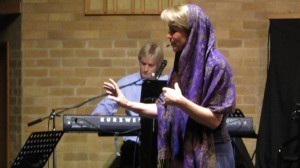Naomi Reed's Blog, page 4
May 6, 2013
May 2013… a good story
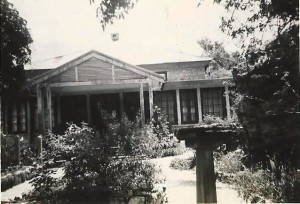 Last week, I sat at our wooden table, typing. Next to me sat a delightful, older lady from our church, dictating. She told me all about her time in North India, fifty years ago – their home on the hill, their friends at the school, the views of the Himalayas, the things God showed her back then… the day her little boy drowned, the day her husband was taken unconscious to the hospital, the day they had to leave India without saying goodbye, the sadness, the enabling, the way she understands grace and mercy now, deeply, fifty years later.
Last week, I sat at our wooden table, typing. Next to me sat a delightful, older lady from our church, dictating. She told me all about her time in North India, fifty years ago – their home on the hill, their friends at the school, the views of the Himalayas, the things God showed her back then… the day her little boy drowned, the day her husband was taken unconscious to the hospital, the day they had to leave India without saying goodbye, the sadness, the enabling, the way she understands grace and mercy now, deeply, fifty years later.
I got a bit teary during the re-telling, and a couple of times I had to stop typing. I felt like hugging her… or just crying, and smiling. And then I felt like praying more, myself. I wanted to learn from her, and sit for longer, and listen better, and pay more attention to God’s hand of grace and mercy, even in the hardest of times. I wanted to say (to myself), ‘It’s okay to cry… and it’s okay to be thankful, both at once’. And then I paused and wondered what I would be saying, to myself, or anyone, in 50 years’ time (if I live to be 95!).
I certainly think there is a perspective that comes, fifty years after an event. There are so many things we can’t see now, in the middle of a hard time… because in the middle of a hard time, it’s a time for tears, and deep grief, and slow healing. It’s a time for reading the shortest verse in the Bible… ‘Jesus wept’, and then reading it over and over again… and imagining him at the house of his friend, and feeling deep grief, in the middle of hope.
But whether it’s in the middle of a hard time, or fifty years later, there is a time for telling our stories. How many times do we go through something moving and significant (where God teaches us deep truths about his love and his ways), yet we hardly tell the people closest to us, let alone further afield. There is surely a time for giving God more glory and credit for his ways and his mercies. There is a time for sitting quietly within his sovereignty and remembering that nothing ever surprises him, or makes him scratch his head. There is a time for looking back and remembering, and then telling our stories to each other, and seeing his hope for the future. But there’s also a bonus – telling our stories to each other connects us as human beings and reminds us of our frailty and our need of a Saviour. It gives us the strength to keep going, because we know that lovely Myrtle Smith, down the road, is also keeping going, in faith, And it helps us to make sense of our stories, and integrate them into our longer story. After a while, we start to own our stories and accept them, and say ‘Well, this is who I am, and this is what God is doing in me, today’.
In March, we held our first Storytelling Conference in Sydney and it was wonderful. All of those things happened! We focused on the elements of story and then moved on to the telling of Bible stories and our own faith stories. Afterwards, the participants said things like… “It helped me explore the Bible in a new and interesting way.” “It helped me focus on the Author of the story and not on myself as a storyteller.” “It reminded me that our stories can make a difference to others and gave me good simple tools to speak about God in the everyday.” “It was a journey to being released, and freed… and to express what has been locked away.”
And here’s some more exciting news… you could come to our next Storytelling Day at Sylvania on May 18th! I’d love to see you there… and I’d love to hear your good stories.
April 2013… the brown snake
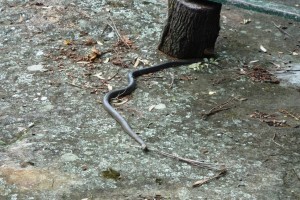 You may not want to know this, but we have a brown snake in our back garden. It appeared for the first time in February, while I was hanging the washing out – its body oozing out of the old stump and its head moving in the direction of the washing. I screamed. Then I ran inside and slammed the door and immediately posted the news on Facebook, hoping for some sympathy or at least someone to scream with me. Fortunately, a few friends screamed with me, and some gave me good advice. Call Wires. Ring 000. Get the dog. Stay on the deck. Cut down the stump. Don’t hang the washing out, ever again.
You may not want to know this, but we have a brown snake in our back garden. It appeared for the first time in February, while I was hanging the washing out – its body oozing out of the old stump and its head moving in the direction of the washing. I screamed. Then I ran inside and slammed the door and immediately posted the news on Facebook, hoping for some sympathy or at least someone to scream with me. Fortunately, a few friends screamed with me, and some gave me good advice. Call Wires. Ring 000. Get the dog. Stay on the deck. Cut down the stump. Don’t hang the washing out, ever again.
For 24 hours, I took their advice. We all stayed on the deck, I put the dog on a lead, ignored the washing and Darren rang Wires. The wires man came and said, “Well, if we caught it, we’d take it away, but it would come back pretty quickly, because the stump is a great home for him and there’s probably food around.”
That wasn’t overly helpful.
The next day though, the sun was shining and the washing was wet, so I put my shoes on and ventured out to the washing line.
“Has anyone seen the snake?” I asked the boys.
“No…” they all replied, cheerfully.
I picked up the first sock and the first peg, and then the snake appeared from behind the old garage, coming straight for me, fast, about three feet away.
I screamed, louder than before, and I ran, faster than before. This time, I didn’t stop shaking all afternoon.
I decided during the next week, that it’s one thing to see a snake by accident, but it’s another thing to watch it come straight for you, in attack mode. I didn’t hang the washing out for a whole week. I didn’t go anywhere near the stump. I tentatively walked around the other part of the garden, but I was twitchy, always looking behind me, checking for the enemy.
And then it was Easter Sunday, and I read John’s account again. “So Judas came to the grove, guiding a detachment of soldiers and some officials from the chief priests and Pharisees. They were carrying torches, lanterns and weapons.” (John 18:3)
They were coming straight for Jesus, three feet away, in attack mode and he knew what was coming next… but he didn’t run away or scream or hide. Instead, he walked towards them, saying, ‘Who is it that you want?” (John 18:4) And they told him, so he said, “I am he.” He gave himself up. One of his friends, who was nearby, had a sword, and “…drew it and struck the high priest’s servant, cutting off his right ear.” (John 18:10) “But Jesus said, “No more of this!” and he touched the man’s ear and healed him.” (Luke 22:51)
It’s amazing. They were a venomous crowd and they were coming straight for him, and Jesus, knowing everything that was coming, gave himself up. He didn’t run inside or scream, or call his friends, or his father, or even ten thousand angels, who could have saved him. He stayed where he was and he touched the man’s ear and he spoke calmly and the next day, he picked up his cross, and all of their venom, and dealt with it forever… because he wanted to give us the better thing – a new place, a safe place, a restful place, a place without snakes, or venom, or fear, or screaming, a place with him, forever.
Today, I walked back to the washing line, barefoot, and I looked inside the stump. Darren has filled the entire space up with thick grey concrete and the boys have written their names in the top. I wriggled my toes in the soft grass, and enjoyed the feel of tiny black ants. I didn’t look behind me, or behind the garage, or beneath the deck, for the enemy. I just hung the washing out.
One day, I thought, it will be like this, forever… all of the time.
February 15, 2013
February 2013… another chance
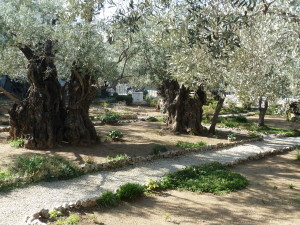 My husband has a favourite line and he uses it whenever he can, especially when we’re discussing anything new – a bike ride, a tennis game, or a trip to Timbuktu. Typically, the discussion meanders along for a while and then at some point, he says, “Sure, we can do that. Why not? We might not get another chance.” And then we both laugh and agree and head off to Timbuktu, or tennis.
My husband has a favourite line and he uses it whenever he can, especially when we’re discussing anything new – a bike ride, a tennis game, or a trip to Timbuktu. Typically, the discussion meanders along for a while and then at some point, he says, “Sure, we can do that. Why not? We might not get another chance.” And then we both laugh and agree and head off to Timbuktu, or tennis.
So part way through last year, we were talking about our January holidays and whether it might be our last one, as a family.
“Where should we go?” asked Darren.
“Jerusalem?” I suggested.
“Sure,” he said. “We can do that. We might not get another chance.”
So we did. We went to Jerusalem in January and we stayed in a small apartment near the Old City. It had a kosher kitchen and a Shabbat elevator and it was 15 minutes’ walk from the Jaffa Gate, which is the main entrance to the Old City. We all loved it. Even the boys got up early every morning to walk down the cobblestone streets, through the main gate and into the Old City. We explored walls and ramparts and laneways and markets and by day three, we had decided that the best flat bread and hummus was found through the Damascus Gate and towards the Muslim Quarter. We also poured over our maps and Bibles – and discovered the Tomb of David, Hezekiah’s tunnel, the Wailing Wall, the Pool of Bethesda, the Garden Tomb and the Upper Room. It was all amazing. It was like the stories from the Bible, that we’d always read and imagined, were suddenly painted on a 3D backdrop, with the smells of olives all around us, and the rough ground beneath us, and the sounds of Shabbat prayers ringing in our ears.
But the very best bit for me, was on the other side of the Old City, heading up towards the Mount of Olives. If you walk down the Southern side of the city and past the Kidron Valley, the road veers left and makes its way up to the other side of the hill. About a hundred metres up, inside an old stone wall, there’s a grove of olive trees – the garden of Gethsemane – the place Jesus where came to pray. John 18 tells us that, “When he had finished praying (in the Upper Room), Jesus left with his disciples and crossed the Kidron Valley. On the other side there was an olive grove, and he and his disciples went into it. Now Judas, who betrayed him, knew the place, because Jesus had often met there with his disciples.” Luke 21 also tells us that Jesus went there every night of his last week. And on his very last night, he chose to go there again, because he knew he wouldn’t have another chance.
The day we went was overcast, and one of the boys asked if it would snow again. We didn’t know. Then we walked into the garden and we were all quiet. Inside the garden there were eight old olive trees, gnarled and bony and tired. Beneath the trees, there were pathways of pebbles and patches of dirt. I could almost see his body kneeling there, his sweat dripping off his face, like drops of blood. He knew what was coming. I knew the story and I started to cry. A small sparrow darted between the patches of alyssum. Then I looked up and imagined the soldiers arriving with lanterns and weapons. On the other side of the garden there was a very small sign, “And the disciples forsook him and fled.” (Mark 14:50)
“Oh Lord,” I prayed, “Thank you. Thank you that I can stand here today… and for what happened here 2,000 years ago. And please help me to stay awake – to be thankful and watchful… and remind me of the cost you bore, to make me yours. And tomorrow when I get up again, or land back in Australia, help me to be thankful there as well, within all of those assumed sights and ordinary tasks, within all of those bike rides and tennis games – help me to remember that you rose from the dead… that I could be forgiven. And please help me when I’m feeling grumbly and tired and daunted… to live each moment, as if I may not get another chance. Amen”
January 11, 2013
Markup: HTML Tags and Formatting
Header one
Header two
Header three
Header four
Header five
Header six
Blockquotes
Single line blockquote:
Stay hungry. Stay foolish.
Multi line blockquote with a cite reference:
People think focus means saying yes to the thing you’ve got to focus on. But that’s not what it means at all. It means saying no to the hundred other good ideas that there are. You have to pick carefully. I’m actually as proud of the things we haven’t done as the things I have done. Innovation is saying no to 1,000 things. Steve Jobs – Apple Worldwide Developers’ Conference, 1997
Tables
Employee
Salary
John Doe
$1
Because that’s all Steve Jobs needed for a salary.
Jane Doe
$100K
For all the blogging she does.
Fred Bloggs
$100M
Pictures are worth a thousand words, right? So Jane x 1,000.
Jane Bloggs
$100B
With hair like that?! Enough said…
Definition Lists
Definition List Title
Definition list division.
Startup
A startup company or startup is a company or temporary organization designed to search for a repeatable and scalable business model.
#dowork
Coined by Rob Dyrdek and his personal body guard Christopher “Big Black” Boykins, “Do Work” works as a self motivator, to motivating your friends.
Do It Live
I’ll let Bill O’Reilly will explain this one.
Unordered Lists (Nested)
List item one
List item one
List item one
List item two
List item three
List item four
List item two
List item three
List item four
List item two
List item three
List item four
Ordered List (Nested)
List item one
List item one
List item one
List item two
List item three
List item four
List item two
List item three
List item four
List item two
List item three
List item four
HTML Tags
These supported tags come from the WordPress.com code FAQ.
Address Tag
1 Infinite Loop
Cupertino, CA 95014
United States
Anchor Tag (aka. Link)
This is an example of a link.
Abbreviation Tag
The abbreviation srsly stands for “seriously”.
Acronym Tag (deprecated in HTML5)
The acronym ftw stands for “for the win”.
Big Tag (deprecated in HTML5)
These tests are a big deal, but this tag is no longer supported in HTML5.
Cite Tag
“Code is poetry.” –Automattic
Code Tag
You will learn later on in these tests that word-wrap: break-word; will be your best friend.
Delete Tag
This tag will let you strikeout text, but this tag is no longer supported in HTML5 (use the instead).
Emphasize Tag
The emphasize tag should italicize text.
Insert Tag
This tag should denote inserted text.
Keyboard Tag
This scarsly known tag emulates keyboard text, which is usually styled like the tag.
Preformatted Tag
This tag styles large blocks of code.
.post-title {
margin: 0 0 5px;
font-weight: bold;
font-size: 38px;
line-height: 1.2;
and here's a line of some really, really, really, really long text, just to see how the PRE tag handles it and to find out how it overflows;
}
Quote Tag
Developers, developers, developers… –Steve Ballmer
Strike Tag (deprecated in HTML5)
This tag shows strike-through text
Strong Tag
This tag shows bold text.
Subscript Tag
Getting our science styling on with H2O, which should push the “2″ down.
Superscript Tag
Still sticking with science and Isaac Newton’s E = MC2, which should lift the 2 up.
Teletype Tag (deprecated in HTML5)
This rarely used tag emulates teletype text, which is usually styled like the tag.
Variable Tag
This allows you to denote variables.
January 10, 2013
Markup: Image Alignment
Welcome to image alignment! The best way to demonstrate the ebb and flow of the various image positioning options is to nestle them snuggly among an ocean of words. Grab a paddle and let’s get started.
On the topic of alignment, it should be noted that users can choose from the options of None, Left, Right, and Center. In addition, they also get the options of Thumbnail, Medium, Large & Fullsize.
[image error]
The image above happens to be centered.
[image error]The rest of this paragraph is filler for the sake of seeing the text wrap around the 150×150 image, which is left aligned.
As you can see the should be some space above, below, and to the right of the image. The text should not be creeping on the image. Creeping is just not right. Images need breathing room too. Let them speak like you words. Let them do their jobs without any hassle from the text. In about one more sentence here, we’ll see that the text moves from the right of the image down below the image in seamless transition. Again, letting the do it’s thang. Mission accomplished!
And now for a massively large image. It also has no alignment.
[image error]
The image above, though 1200px wide, should not overflow the content area. It should remain contained with no visible disruption to the flow of content.
[image error]
And now we’re going to shift things to the right align. Again, there should be plenty of room above, below, and to the left of the image. Just look at him there… Hey guy! Way to rock that right side. I don’t care what the left aligned image says, you look great. Don’t let anyone else tell you differently.
In just a bit here, you should see the text start to wrap below the right aligned image and settle in nicely. There should still be plenty of room and everything should be sitting pretty. Yeah… Just like that. It never felt so good to be right.
And just when you thought we were done, we’re going to do them all over again with captions!
[image error]
Look at 580×300 getting some caption love.
The image above happens to be centered. The caption also has a link in it, just to see if it does anything funky.
[image error]
Itty-bitty caption.
The rest of this paragraph is filler for the sake of seeing the text wrap around the 150×150 image, which is left aligned.
As you can see the should be some space above, below, and to the right of the image. The text should not be creeping on the image. Creeping is just not right. Images need breathing room too. Let them speak like you words. Let them do their jobs without any hassle from the text. In about one more sentence here, we’ll see that the text moves from the right of the image down below the image in seamless transition. Again, letting the do it’s thang. Mission accomplished!
And now for a massively large image. It also has no alignment.
[image error]
Massive image comment for your eyeballs.
The image above, though 1200px wide, should not overflow the content area. It should remain contained with no visible disruption to the flow of content.
[image error]
Feels good to be right all the time.
And now we’re going to shift things to the right align. Again, there should be plenty of room above, below, and to the left of the image. Just look at him there… Hey guy! Way to rock that right side. I don’t care what the left aligned image says, you look great. Don’t let anyone else tell you differently.
In just a bit here, you should see the text start to wrap below the right aligned image and settle in nicely. There should still be plenty of room and everything should be sitting pretty. Yeah… Just like that. It never felt so good to be right.
And that’s a wrap, yo! You survived the tumultuous waters of alignment. Image alignment achievement unlocked!
January 9, 2013
Markup: Text Alignment
This is a paragraph. It should not have any alignment of any kind. It should just flow like you would normally expect. Nothing fancy. Just straight up text, free flowing, with love. Completely neutral and not picking a side or sitting on the fence. It just is. It just freaking is. It likes where it is. It does not feel compelled to pick a side. Leave him be. It will just be better that way. Trust me.
Left Align
This is a paragraph. It is left aligned. Because of this, it is a bit more liberal in it’s views. It’s favorite color is green. Left align tends to be more eco-friendly, but it provides no concrete evidence that it really is. Even though it likes share the wealth evenly, it leaves the equal distribution up to justified alignment.
Center Align
This is a paragraph. It is center aligned. Center is, but nature, a fence sitter. A flip flopper. It has a difficult time making up its mind. It wants to pick a side. Really, it does. It has the best intentions, but it tends to complicate matters more than help. The best you can do is try to win it over and hope for the best. I hear center align does take bribes.
Right Align
This is a paragraph. It is right aligned. It is a bit more conservative in it’s views. It’s prefers to not be told what to do or how to do it. Right align totally owns a slew of guns and loves to head to the range for some practice. Which is cool and all. I mean, it’s a pretty good shot from at least four or five football fields away. Dead on. So boss.
Justify Align
This is a paragraph. It is justify aligned. It gets really mad when people associate it with Justin Timberlake. Typically, justified is pretty straight laced. It likes everything to be in it’s place and not all cattywampus like the rest of the aligns. I am not saying that makes it better than the rest of the aligns, but it does tend to put off more of an elitist attitude.
December 17, 2012
December 2012… dirty shoes and an invitation
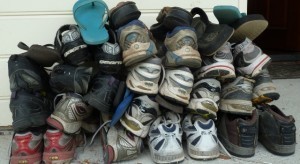
We’ve been back in Australia for six years now and we still leave our shoes by the front door, lots of them – running shoes and bike shoes and soccer boots and different coloured chappals, all multiplied by five, not to mention the extras, if there are guests.
So today, I bent down and rearranged the rather large stack into a neater pile, because it’s that time of year and we’re having friends for dal bhat and I’m vaguely trying to get things in order for Christmas. So I put the soccer boots at the very bottom, the runners on the next level, followed by the bike shoes and the different coloured chappals at the very top. Then I surveyed my pile and enjoyed it. I even took a photo.
But I didn’t think about moving the shoes, or hiding them away for Christmas, or pretending that we don’t have a pile of dirty shoes by the front door… because I like our shoes by the front door. I like the way they sit there and remind me that we’re a family and we have a lot of messy shoes. I like the way they tell me that we’ve lived in other places, like Nepal, where shoes and boots and chappals were always left by the front door, every day. And I like the habit itself – I like the fact that we make a deliberate distinction between the outside and the inside…. because the outside is for dust and footpaths and overgrown grass by the lagoon… and the inside is for something cleaner and warmer, and hopefully more real and honest and even intimate. If you can find your way past the pile of shoes at our front door, you will soon be in the hallway, and then, even better, the kitchen, where there will be a hot cup of tea, and acceptance, regardless of the mood, and even moments of rich conversation. And, this is an aside, but with any luck, we’ll have more time for tea and rich conversation because I won’t be sweeping the floor quite so often!
I enjoy it at every level, but most of all, I like seeing the pile of shoes at the front door because they remind me of God’s invitation – to come inside, daily… forgiven, redeemed, accepted, clean, and shoe-less… because way back in 535BC, God spoke through the prophet Ezekiel and he said, “I will sprinkle clean water on you, and you will be clean. I will cleanse you from all impurities and from all your idols…” and then hundreds of years later, he brought that about through his only Son, Jesus, who came and loved and lived and died and rose again, so that we could be clean, forever.
That’s what I’m celebrating this Christmas.
November 20, 2012
Late November 2012… ballet shoes
I used to dance, when I was young, four times a week… ballet and jazz and folk, but mostly ballet. I loved it – the old community hall and the wooden floors and the sounds of the piano and the way we would pirouette from the corner. Even now, 25 years since my last class, I can still feel the blisters on my toes, scrunched into pointe shoes… and if I walk past a railing that looks anything like a barre, I’m tempted to try an arabesque. I don’t normally, because I would hurt myself, but I’m tempted.
And then in March this year, it all began again. I tried performing the Story of the Coins, to live music. At first, I didn’t think I could, because narrative is so different to movement. It’s so much harder to control and keep consistent with the music, than an arabesque. So I was on the stage, fiddling with my radio mic and my scarf, nervous, until the piano began to play… and then I relaxed. I went back to my childhood, where the piano used to tell me what to do, and where to go, and how quickly, and what to feel, and how innately to ‘be’. So then afterwards, in my delight, I decided to take pre-recorded keyboard music with me everywhere, and use it as a backdrop for my gospel narratives. My talented piano man and producer, Bruce Wheatley, sighed again and told me it would be harder. I told him I could dance. He told me it would be harder to time silence. Then we compromised and recorded anyway… and I tried it for the first time in Bendigo. Bruce was right! It was hard… and I didn’t time the silence perfectly. But it was close… and the music calmed me down and the message was clear and the people responded and I’ve been doing it all year.
So today, I re-read my favourite quote by Corrie ten Boom, “Every experience God gives us, every person he puts on our path, is the perfect preparation for a future that only He can see.” Until this year, I’ve always thought the quote was helpful when we were in hard times and difficult seasons and feeling the brunt of things we don’t understand. God uses them, in ways beyond what we can see, which is true. But now, today, I’m realizing that God also uses our old, beautiful, childhood things, the dancing and the piano music and the wooden floors, in the story he’s writing in our lives, for his glory. That’s lovely.
November 2012 …friendship
I hardly ever sit in a coffee shop by myself. Actually, that’s not true. I sit in them by myself at airports, but I hardly ever sit in them alone locally… because local coffee shops are for meeting friends. And happily, in the Blue Mountains, there are a nice array of coffee shops, and an even nicer, tight selection of friends. We usually meet on the hour, lean forward and buzz about our worries and dreams and smiley things and funny family episodes. Occasionally, we groan and cry. Afterwards, I may not be able to tell you what colour they were wearing, or the bag they were carrying, or whether they wore nail polish or not… but I could tell you about the energy that poured out of their eyes and their smiles.
Then last week, I sat alone. Stevie was doing his driving test in Springwood and I was too nervous to drive anywhere, so I sat alone in a coffee shop and ordered a very hot cup of chai. Of course, on every other table, there were friends meeting and sharing their stories. And I didn’t deliberately mean to, but I did catch phrases of their conversations. Apparently, nervous writers are allowed to do that. Behind me, for example, there was a girl who was pregnant, too early. She hadn’t finished her studies yet, so her voice sounded worried. She wanted to keep studying… but she didn’t know how she would do that. Her friend listened to her for a long time and mostly just said ‘Mmm’. Then after a while, the friend said, ‘You could maybe wait for a month and see how you go?’ The girl agreed and they kept drinking and talking.
As they did, I checked my watch and finished my hot chai and thought about friendship. It’s a peculiar, beautiful thing. It doesn’t always give answers or advice. It rarely dictates or prescribes or even complains about the washing. It just sits. And as it sits, it listens and cries and laughs and prays and groans. And after a very long time of sitting and listening and crying and laughing and praying and groaning, we feel like we can get up and keep going… because we have a friend, a single person in the universe, who understands.
Lord, thank you for our friends… that you bring into our lives at just the right time. Thank you for the way they listen, and cry and laugh and pray and groan with us. Help us to be a friend like that, today.
October 2012… in the green gazebo
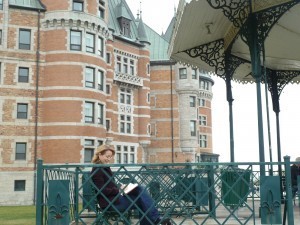
The gazebo in front of the Chateau Frontenac
Last month, Darren and I spent time in North America. It was Fall. We landed in the Old City, Quebec, where he presented his PhD research and I walked beneath the Maple leaves. Then we travelled south and stared at the fury of Niagara Falls, feeling it wet on our faces. After two days, we caught a train to New York City, and walked in Central Park, thinking about stories. At the end of the fortnight, we flew to Tulsa, Oklahoma, where I spoke at an INF dinner and we also ate the best burgers in the world.
It was lovely… all of it, especially the time in Quebec. I’ve decided that distracted writers (and all of us) need time to do nothing at all… especially nothing urgent, pre-arranged or related to the house. For six mornings in a row, Darren got up and walked to the Conference, and I got up and walked to a green and white gazebo in front of the Chateau Frontenac. Along the way I stared at gable windows and skidded on wet maple leaves and thought about stories. Then I sat down in the gazebo and watched the tourists as they walked along the boardwalk by the Fleuve Saint-Laurent. I smelt the presence of the hot dog man, who sat beneath the gazebo. I listened to the busker as she took out her clarinet and played jazz. Then I got out our portable laptop and typed as if I couldn’t not type. For six whole days, while the jazz played, I typed faster and faster and the typing turned into Chapter One of a whole new book, called, ‘If you had time for… One Last Story… what would it be?’
It was a beautiful six days. We also ate out every night and went walking beneath a full moon and figured out how to boil a kettle on the windowsill, so that added to the beauty. But this month, Darren and I and the boys are all back at home in the Blue Mountains, doing lots of urgent, pre-arranged, scheduled things that aren’t quite as beautiful. It’s not quite Quebec. In fact, it’s not Quebec at all, and part of me wishes I could pop back there and sit in the gazebo and find out what happens in Chapter Two. Maybe if I had time and beauty, I think, I could finish the book and everything would be easier.
But this morning, I walked to the Post Office and noticed the Jacarandas are turning purple. I heard Jeremy’s laugh as he rode down the street to school. In my known place, and amongst my familiar people, there is still beauty. The boys don’t often greet me with ‘Bonjour Madam’, but they speak to me in voices that I love. And while it’s true that the unfamiliar brings new thoughts and words and inspiration, the familiar brings intimacy. And it’s the intimacy that I love and crave. In Quebec, I can be a stranger and spoken to with respect by the hot dog man, but I can’t be known and I can’t be loved and I can’t be trusted. For that, I have to go home.
Lord, thank you for our homes and the Jacaranda trees, and the sounds of the people we love. Thank you that they know us and love us and trust us… and please help us to love them in return.
Naomi Reed's Blog
- Naomi Reed's profile
- 14 followers


